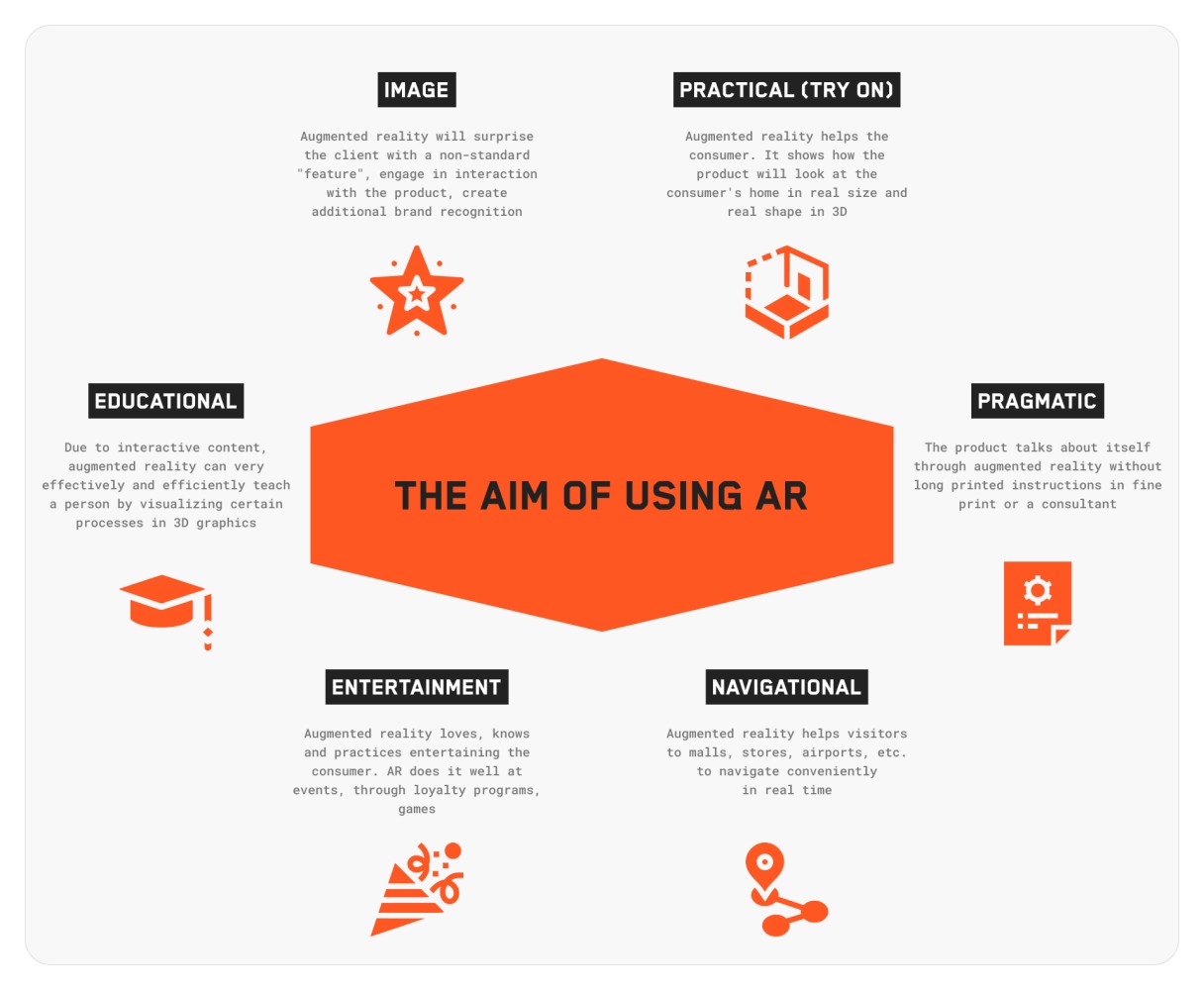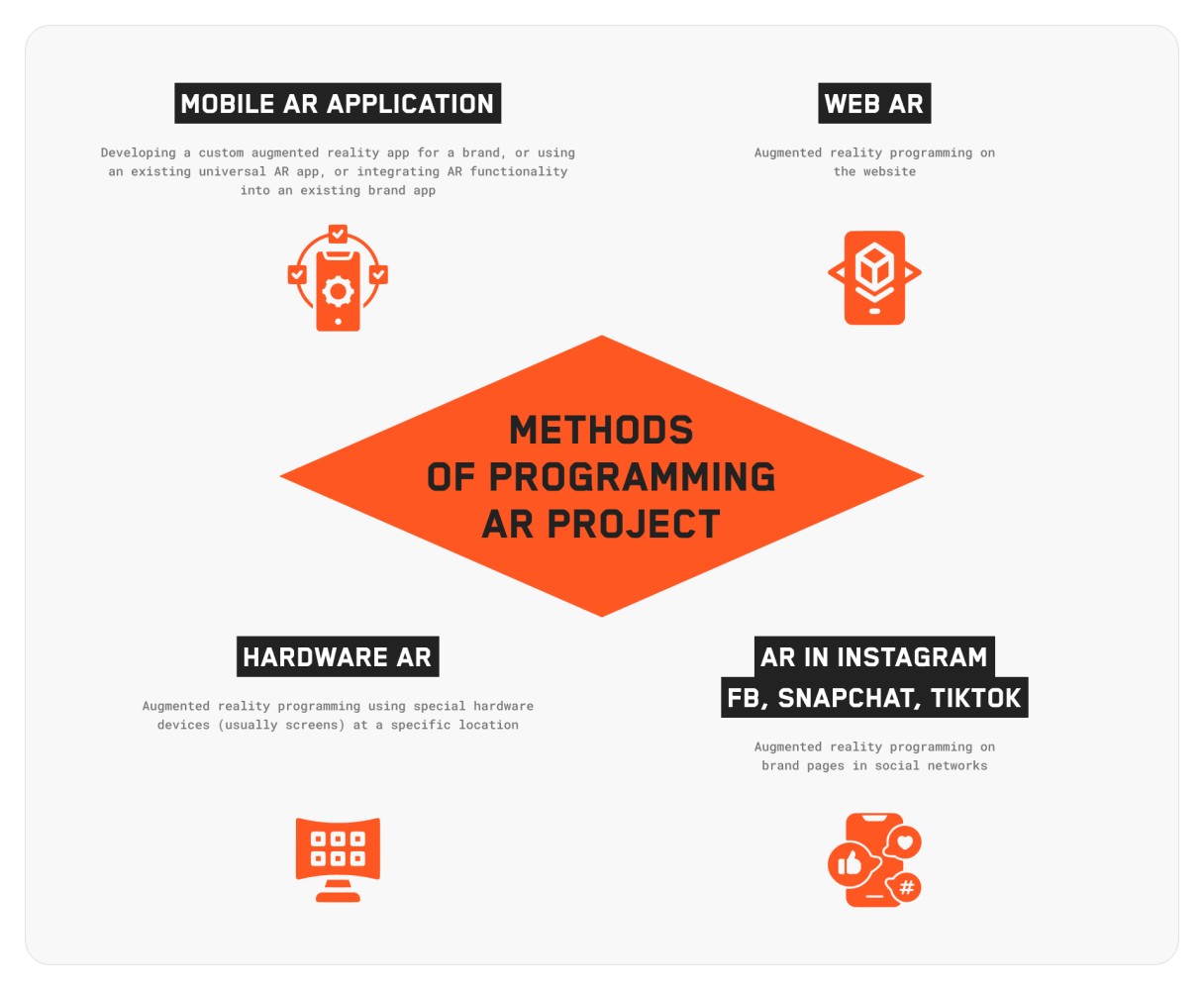HOW CAN A BRAND CREATIVELY INTEGRATE AUGMENTED REALITY INTO BUSINESS

Augmented reality is one of the key tools in 3D marketing as a completely new direction, which is aimed at meeting the immersive needs of the modern consumer.
Augmented reality lives in a smartphone.
BUSINESS GUIDE TO INTEGRATION OF AUGMENTED REALITY:
- The brand decided to try augmented reality in its advertising and marketing activities
- The brand realized that augmented reality (AR) lives in a smartphone, and virtual reality (VR) – in special VR glasses. And after that, brand once again made sure that it wanted augmented reality, so that it consumer would be able to activate AR-activity through smartphone in any part of the world
- The brand clearly understands the portrait of its target consumer. The brand clearly understands where and when the consumer interacts with the product. Product consumer = augmented reality consumer
- The brand needs to highlight the purpose of using augmented reality ✅

4.1. Image. Augmented reality will surprise the client with a non-standard “feature”, engage in interaction with the product, create additional brand recognition. Augmented reality does not help the consumer in solving practical problems – it creates a WOW effect, which affects the consumer’s emotions, and therefore increases the time of contact with the brand and its loyalty.
4.2. Practical (try on). Augmented reality helps the consumer. It shows how the product will look at the consumer’s home in real size and real shape in 3D (Agree, it’s better than looking at a flat picture on the website of an online store and wondering if this sofa will fit under the new wallpaper 😉) or creates the opportunity to try on the product in 3D.
4.3. Pragmatic. The product talks about itself through augmented reality without long printed instructions in fine print or a consultant. Interactive instructions for using the product, its 3D assembly or a virtual consultant help the consumer to perceive information faster, save time and nerves 😁
4.4. Navigational. Augmented reality helps visitors to malls, stores, airports, etc. to navigate conveniently in real time.
4.5. Entertaining. Augmented reality loves, knows and practices entertaining the consumer. AR does it well at events, through loyalty programs, games. This is gamification, which is very much loved by the modern consumer.
4.6. Educational. Due to interactive content, augmented reality can very effectively and efficiently teach a person by visualizing certain processes in 3D graphics. It is very useful for historical and cultural objects, exhibition centers, educational institutions, medicine, etc.
- The brand must choose the format of the content that will be displayed in AR.
Content in AR can be in the form of:

The format of the content should be determined according to the objectives of the AR campaign, the target consumer and the brand product that will be used with AR. 3D graphics are most often used.
- Once the content format is chosen, the brand needs to develop a script for the content that will be broadcast in AR. It should clearly correspond to the interests of the target consumer, the company’s marketing strategy, the purpose of using augmented reality within the campaign and carry an appropriate call to action. Content is the most important thing. This is what the consumer sees and interacts with through his smartphone 📱. This is the core of the AR project. It is the content that determines the success or failure of a campaign.
- The brand needs to determine the duration of the AR campaign – the time that augmented reality will “live” together with the brand’s product ⏳
- Image or entertainment aim have an average campaign duration of 3-6 months.
- Practical or pragmatic aims have a term equal to the term of relevance of the product and its duration of sales.
- The navigation aim has a long-term duration with the possibility of operational updates of locations.
- The educational aim has a medium-term and long-term duration according to the relevance of the content to be demonstrated in AR
- The brand determines how the consumer will activate the AR content or, in another way, how the project will be programmed 🔄
There are four ways to program an AR project:

Mobile AR application.
Developing a custom augmented reality app for a brand, or using an existing universal AR app, or integrating AR functionality into an existing brand app.
To activate AR, the consumer needs to download the app. Suitable for all six AR campaign objectives ✅
WEB AR.
Augmented reality programming on the site.
To activate AR, the consumer needs to go to the brand’s website and click on the relevant AR button.
Suitable for AR campaign objectives 1, 2 and 3. May be partially suitable for 5 and 6. Not suitable for 4 (navigational) purpose ✅
AR in social networks Instagram, Facebook, Snapchat, TikTok
Augmented reality programming on brand pages in social networks.
To activate AR, the consumer needs to go to the brand’s page on social networks.
Suitable for 1, 2 and 5 AR campaign objectives. Partially suitable for 4 and 6. Not suitable for 4 (navigational) target ✅
Hardware augmented reality
Augmented reality programming using special hardware devices (usually screens) at a specific location.
To activate AR, the consumer needs to be close to the screen. Suitable for 1st and 5th purpose ✅
- Once the content format is selected, the programming method is selected and the script is developed, you can start creating the magic that will ADD AR activity to the brand to WIN over the competition.
Guide from ADVIN
